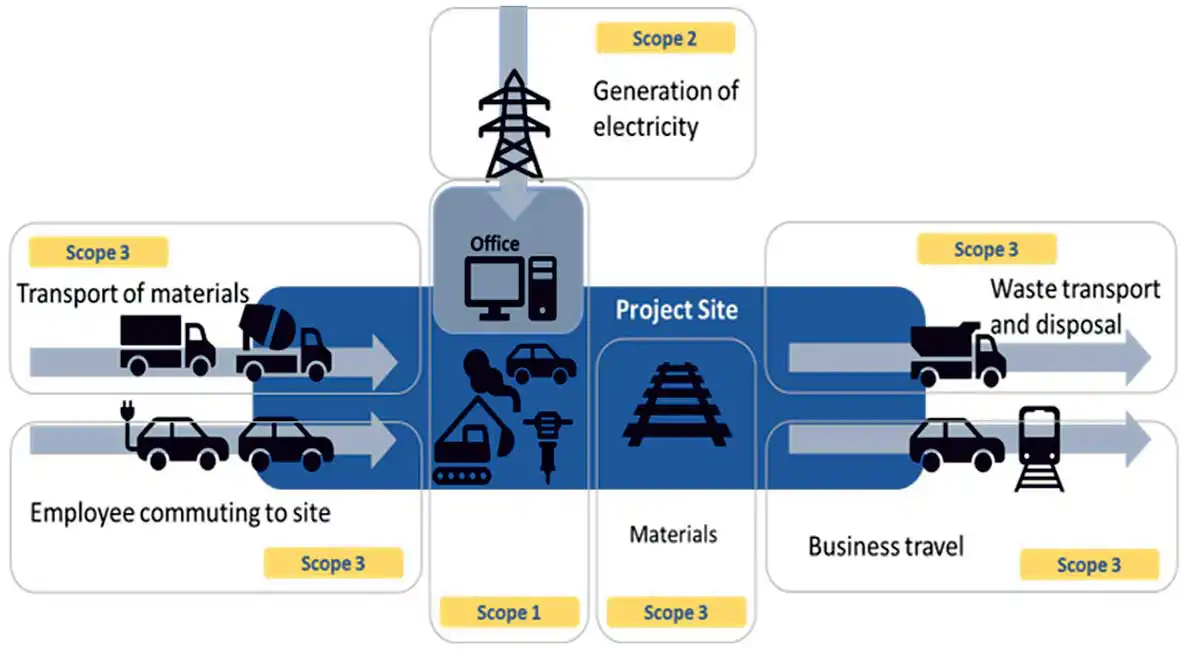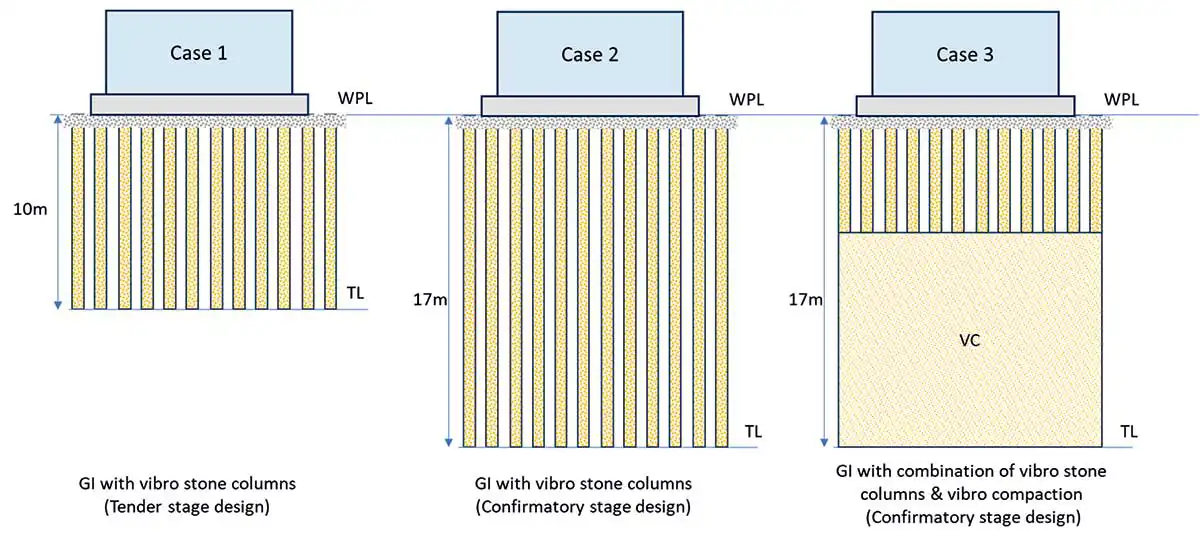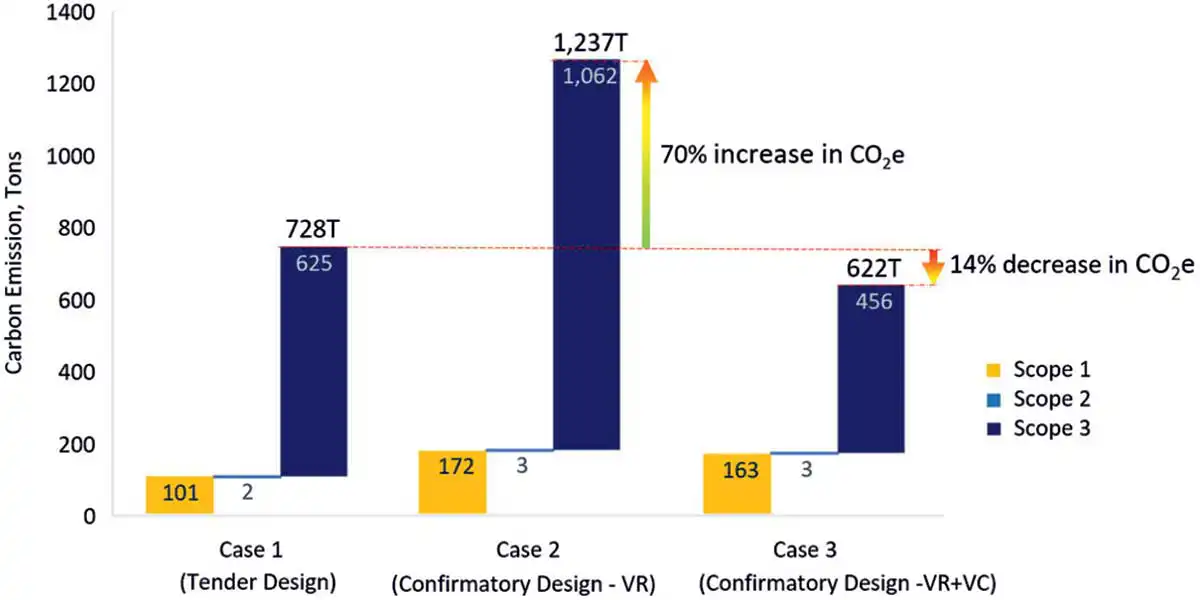Building Sustainable Foundations for Infrastructure Projects
Foundation construction is one of the leading industries contributing to infrastructure’s carbon footprint. The amount of greenhouse gases (GHG) released into the atmosphere due to geotechnical construction activity is an average of 15 - 23% of the overall embodied carbon of a project (WRAP, 2015). To address this growing concern, sustainable foundations have emerged as the cornerstone of India’s infrastructure projects, striking a balance between progress and environmental protection.
Madan Kumar Annam, Head of Engg, and Anurag Chafale, Dy. Manager, Keller India.
Ground improvement technologies provide a compelling approach to achieving a sensitive balance between development and conservation. The government of India has initiated the promotion of green constructions and technology through building energy efficiency actions in Nationally Determined Contribution (NDC, 2015) wherein a major focus was given to carbon emissions in various phases of the construction life cycle, namely raw material consumption, construction management, operation, discarding and dismantling, and end-of-life disposal/reuse (Rawal et al. 2014, Nuri et al. 2020).
According to the IPCC (2018), GHG emissions are categorized into three types:
 Figure 1: Carbon emission categories according to GHG (IPCC (2018)
Figure 1: Carbon emission categories according to GHG (IPCC (2018)
The increased utilization of steel, cement, and diesel in foundation construction leads to substantial release of greenhouse gases into the atmosphere. The role of Geotechnical engineers includes implementing counter measures to mitigate direct carbon emissions using environmental friendly foundation solutions. This involves selecting optimized designs, employing the most efficient machinery, and utilizing more sustainable materials.
Various attempts are being made by researchers and practicing geotechnical engineers for carbon emission reductions via utilization of ground heat energy using geothermal energy piles (DTI et al. 2005, Sani et al. 2019), use of ground improvement techniques (Serridge et al. 2005, Jefferis 2005, Jefferson et al. 2009, Hari et al. 2021), and through reuse of foundation or its recycled materials (Butcher et al. 2006).
Prior to its development in 2014, there existed no single standardized tool for calculating CO2 emissions for these types of ground works. The tool also allows contractors to compare different technical approaches within the same project and see what CO2 emissions will be generated for the selected foundation solution. Furthermore, this calculator can be used throughout a project’s development, to validate how it performed against expectations. (Source: www.effc.org).
While handling foundation solutions of a sewerage treatment plant in North India, a notable variation in soil investigation data was observed between the tender and execution stages. During the tender stage, it was recommended to implement soil improvement measures to a depth of 10m to tackle the liquefaction (Case 1).
The project’s schedule and cost considerations were determined based on the extent of specified treatment depth. However, results of confirmatory investigation revealed that the subsoil was susceptible to liquefaction to a depth of 17m, which exceeded the initial tender stage assessment. This would have significantly increased the quantity of stone materials and usage of machinery. Such a situation draws the attention of the engineer for optimizing the foundation solution, while considering the costs, time, and impact of carbon footprint. Figure 2 illustrates various ground improvement options selected for study.
 Figure 2: Illustration of various ground improvement options
Figure 2: Illustration of various ground improvement options
Based on the detailed assessment of subsoil and multiple field trials, a combination of vibro stone columns and vibro compaction was proposed as a cost-effective and environmental friendly solution. A comparative study was undertaken to assess the impact of carbon footprint due to increased quantity of materials and machinery and further reduction by geotechnical design optimization.
Two types of ground improvement solutions were selected in this study in addition to the tender stage proposal. The study is done for increased depth of treatment using vibro stone columns up to 17m depth (Case 2) and other optimized ground improvement solution using a combination of vibro stone columns and vibro compaction (Case 3).
 Figure 3: Demonstration of carbon emissions for various cases
Figure 3: Demonstration of carbon emissions for various cases
Madan Kumar Annam, Head of Engg, and Anurag Chafale, Dy. Manager, Keller India.
Need for Sustainability
India’s rapid economic growth and urbanization have moved into a new era of infrastructure development. As the nation is growing with ambitious projects aimed at connectivity, energy, and urbanization, the environmental impact of such development poses a sustainability concern. It is unfortunate that urbanization and infrastructure expansion often come at the expense of natural resources and ecosystems. The integration of sustainable foundations will be critical in creating a healthy environment for future generations.Ground improvement technologies provide a compelling approach to achieving a sensitive balance between development and conservation. The government of India has initiated the promotion of green constructions and technology through building energy efficiency actions in Nationally Determined Contribution (NDC, 2015) wherein a major focus was given to carbon emissions in various phases of the construction life cycle, namely raw material consumption, construction management, operation, discarding and dismantling, and end-of-life disposal/reuse (Rawal et al. 2014, Nuri et al. 2020).
According to the IPCC (2018), GHG emissions are categorized into three types:
- Scope 1 is direct emission, which is mostly from the consumption of fuel by drill rigs and construction equipment.
- Scope 2 is indirect emissions due to the consumption of electricity in offices, supporting facilities, and maintenance yards.
- Scope 3 includes all other indirect emissions generated due to the manufacturing of machines, materials, transportation of materials, and associated construction activities.
 Figure 1: Carbon emission categories according to GHG (IPCC (2018)
Figure 1: Carbon emission categories according to GHG (IPCC (2018)Role of Geotechnical Engineer in addressing sustainability
Geotechnical engineers have a crucial role in influencing the sustainability credentials of any foundation solution due to its early position in building infrastructure projects. The construction of foundations significantly impacts the carbon footprint, given the extensive use of heavy machinery and the consumption of anthropogenic or other manufactured materials like steel and cement.The increased utilization of steel, cement, and diesel in foundation construction leads to substantial release of greenhouse gases into the atmosphere. The role of Geotechnical engineers includes implementing counter measures to mitigate direct carbon emissions using environmental friendly foundation solutions. This involves selecting optimized designs, employing the most efficient machinery, and utilizing more sustainable materials.
Various attempts are being made by researchers and practicing geotechnical engineers for carbon emission reductions via utilization of ground heat energy using geothermal energy piles (DTI et al. 2005, Sani et al. 2019), use of ground improvement techniques (Serridge et al. 2005, Jefferis 2005, Jefferson et al. 2009, Hari et al. 2021), and through reuse of foundation or its recycled materials (Butcher et al. 2006).
International Collaborations and Knowledge Exchange
The EFFC (European Federation for Foundation Contractors) and DFI (Deep Foundations Institute) have created a tool that will calculate the CO2 emissions (CO2e) of foundation and geotechnical works. It is designed to allow contractors and commissioning organizations to assess the carbon footprint of their projects. The EFFC/DFI Carbon Calculator has been developed using verifiable, standardized data to enable accurate benchmarking of competing project proposals.Prior to its development in 2014, there existed no single standardized tool for calculating CO2 emissions for these types of ground works. The tool also allows contractors to compare different technical approaches within the same project and see what CO2 emissions will be generated for the selected foundation solution. Furthermore, this calculator can be used throughout a project’s development, to validate how it performed against expectations. (Source: www.effc.org).
Ground improvement techniques with no binders
Here, a case study is identified and discussed on how to reduce carbon footprint by selecting the right foundation solution. It also highlights how alternative construction materials are more carbon-efficient when compared to heavy foundations. The study is done utilizing the EFFC-DFI carbon calculator to quantify the environmental impact.While handling foundation solutions of a sewerage treatment plant in North India, a notable variation in soil investigation data was observed between the tender and execution stages. During the tender stage, it was recommended to implement soil improvement measures to a depth of 10m to tackle the liquefaction (Case 1).
The project’s schedule and cost considerations were determined based on the extent of specified treatment depth. However, results of confirmatory investigation revealed that the subsoil was susceptible to liquefaction to a depth of 17m, which exceeded the initial tender stage assessment. This would have significantly increased the quantity of stone materials and usage of machinery. Such a situation draws the attention of the engineer for optimizing the foundation solution, while considering the costs, time, and impact of carbon footprint. Figure 2 illustrates various ground improvement options selected for study.
 Figure 2: Illustration of various ground improvement options
Figure 2: Illustration of various ground improvement optionsBased on the detailed assessment of subsoil and multiple field trials, a combination of vibro stone columns and vibro compaction was proposed as a cost-effective and environmental friendly solution. A comparative study was undertaken to assess the impact of carbon footprint due to increased quantity of materials and machinery and further reduction by geotechnical design optimization.
Two types of ground improvement solutions were selected in this study in addition to the tender stage proposal. The study is done for increased depth of treatment using vibro stone columns up to 17m depth (Case 2) and other optimized ground improvement solution using a combination of vibro stone columns and vibro compaction (Case 3).
Assessment of carbon footprint
The amount of carbon emissions for Case 1 is about 728 tCO2e (tender stage design). With an increase in treatment depth to 17m, the carbon emission for Case 2 was approximately 1238 tCO2e. This is about 70% higher than that of the tender stage design. However, with proper assessment of the subsoil conditions, this carbon emission can be reduced to 622 tCO2e by adopting combination of vibro stone columns and vibro compaction, instead of vibro stone columns alone. Ground improvement techniques using combination not only helped in addressing the liquefaction but also reduced the carbon emission by 14% compared to tender design. Demonstration of reduction of carbon emissions for various Cases is illustrated in Figure 3. The major contributor of carbon reduction in Case 3 is geotechnical design optimization, which eventually leads to a) less use of crushed stone, b) a reduction in freight distance from aggregate source, c) a reduction in the consumption of water in construction activities and d) less usage of machinery. Figure 3: Demonstration of carbon emissions for various cases
Figure 3: Demonstration of carbon emissions for various casesCarbon emission for case 1, 2 & 3, divided by emission scope
Overall, this case study demonstrates that even when foundations need to be strengthened, there is an opportunity to decarbonize the design. It also demonstrates that even lower carbon geotechnical solutions, like stone columns, can be optimized to further decrease in carbon emissions.
NBM&CW SEPTEMBER 2023
















